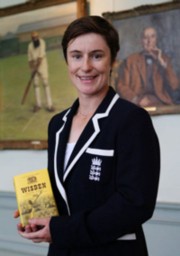Wisden, the cricket-lover’s bible (if there can be a new bible every year), yesterday announced its five Cricketers of the Year. It’s an odd arrangement, because you can only win this title once. So, you can be a totally dominant cricketer, but because you also did fairly well in 2003 and were picked then, you can’t be picked now, again. This year’s crop are accordingly the usual collection of pretty good cricketers who did very well, but who didn’t exactly grab many headlines: perennial nearly-man James Anderson, the best of a rather bad lot of England bowlers, someone called Benkenstein who did well for champion English county Durham, and a couple of the South Africans who recently beat England in England and then Australia in Australia. But one cricketer on the latest list really has done indisputably great things in the previous few months:
Taylor and the England team had been in magnificent form leading up to their World Cup triumph: early in 2008, they retained the Ashes by winning only their fourth Test in Australia; they then went through the entire summer undefeated. Taylor was instrumental in both achievements, and established …
Pay attention:
… herself …
Indeed.
… as the leading batsman in women’s cricket after sealing victory in the Bowral Test.

Said Wisden’s Scyld Berry, of Claire Taylor, the first woman ever to receive this particular form sporting recognition:
Beating Australia in Australia is the objective for all cricketers, at least in England, and Claire almost single-handedly saw England through to victory and the retention of the Ashes in Australia last year, not to mention her success in the World Cup just a couple of weeks back. It would be a sin of omission, an act of prejudice, to exclude her from the accolade.
I wonder if a woman will ever play in one of the international men’s teams, so to speak. The immediate response would probably be: never, except maybe, one day, as a spin bowler, before then collapsing dead of exhaustion. Women, it is now assumed, just don’t have the necessary strength or stamina to challenge the men as top class cricketers. Well, power is certainly one way to do well as a cricketer, as men like Botham, and now Flintoff (who by the way took a match- and one-day series-clinching hat trick yesterday against the West Indians), have proved. But some quite small, even slight, men have excelled at cricket, especially as batsmen. Surely the real reason women do not now regularly challenge men at cricket is that until recently few women have played cricket at all, a state of affairs that is now changing quite fast. Because of the example of women like Claire Taylor, it will probably change quite a bit more in the near future.




perennial nearly-man James Anderson
“nearly-man”? Ouch. That’s harsh.
The whole English bowling attack are nearly men. Harmison had a couple of great seasons, but hasn’t got anywhere near that sort of form since then, and the rest put in an occasional good performance, but are rightly ranked well down the list of top international bowlers. Even Freddie, despite his five-for yesterday, seldom puts in match winning performances, and the fact that we have struggled to take twenty wickets in a Test all winter says it all for me.
As for a woman playing in a men’s Test match? Well I’m sure we could produce a girl who could run around in the field with as much skill, stamina and athleticism as Monty, but whether we could produce one with the ability, reflexes and intestinal fortitude to stand at the wicket when a world class quickie is chucking it down at ninety miles an hour is another thing altogether.
But congratulations to Claire Taylor, (and all the girls who did so well). The accolade is well deserved and she’s certainly the stand out cricketer on that list.
I’m interested in why you think exhaustion would be a factor in women playing men’s cricket. I can’t readily see any reason why a woman couldn’t hop around for a few days as easily as a mildly fit man.
The issue would have to be (as almost always) strength and speed. A fast-bowler, for example, seems intuitively unlikely. But then again, spinning is a game of strength as well, deceptively so.
But why I think you may be right in your prediction (that we will see women in top-flight cricket) is the relative shallowness of the cricket pool. Women are never going to play top-flight soccer, because the pool is so deep. But a very good female athlete could well, imho, make a top-flight cricketer. Perhaps.
The usual question arises. If women are just as qualified, or if there is any idea they might be, why do they have their own league? Why don’t they compete with men so they can get better? Does feminism now abjure Darwin? Would Taylor have won this medal if she had been competing with men? If not, how is she the “standout cricketer on the list”? How many men would have done as well as or better than she did playing against girls? How paternalistically patronizing to insist that the best girl should get a medal for no other real reason than that she’s a girl.
That jacket looks vaguely familiar.
Great catch, Alan!
I seem to recall a certain Sri Lankan team back in ’96 that wasn’t exactly overstaffed with behemoths. Of course they did benefit from the odd forfeiture from teams that didn’t fancy being Tamil targets.